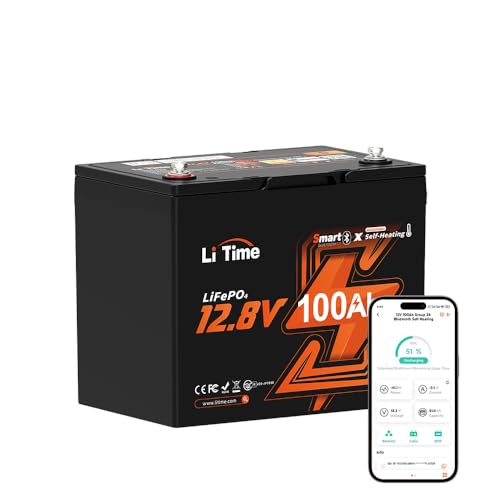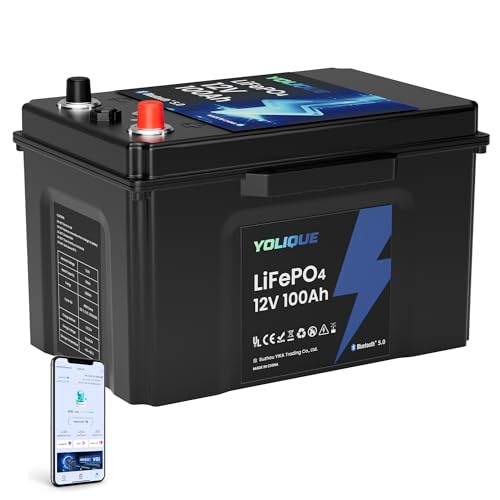Finding a 12V LiFePO4 battery with reliable self-heating is essential for cold-weather charging and long-term off-grid reliability. Below is a concise comparison of top self-heating 12V lithium batteries suitable for RVs, campers, marine, and solar systems. Each selected model includes built-in temperature protection, a BMS, and app or display monitoring where available.
| Model | Brand | Key Feature |
|---|---|---|
| 12V 300AH Bluetooth LiFePO4 (Self-Heating) | VATRER POWER | Automatic self-heating, 200A BMS, 300Ah capacity |
| 12V 100Ah Group 24 Bluetooth Heating LiFePO4 | LiTime | Two heating modes, Bluetooth app, 100A BMS |
| 12V 100AH Group 24 Self-Heating LiFePO4 | TEMGO | Touchable display, app monitoring, automatic heating |
| 12V 206AH LiFePO4 With Built-In Heater | SOK Battery | Built-in heater that charges to -4°F (-20°C), smart BMS |
| 12V 100Ah LiFePO4 With Self-Heating & IP67 | YOLIQUE | IP67 case, Bluetooth monitoring, auto heating |
Content Navigation
- VATRER POWER 12V 300Ah Bluetooth LiFePO4 Battery
- LiTime 12V 100Ah Group 24 Bluetooth Heating LiFePO4 Battery
- TEMGO 12V 100Ah Group 24 Self-Heating LiFePO4 Battery
- SOK 12V 206AH LiFePO4 Battery With Built-In Heater
- YOLIQUE 12V 100Ah LiFePO4 Battery With Self-Heating
- Buying Guide: Choosing The Right 12V Self-Heating LiFePO4 Battery
VATRER POWER 12V 300Ah Bluetooth LiFePO4 Battery

This 12V 300Ah LiFePO4 battery includes an automatic self-heating function activated by the BMS when charging in low temperatures (-4°F to 41°F activation). The heating stops once the pack reaches 41°F, then normal charging resumes. The battery is built with automotive-grade cells and an upgraded 200A BMS that protects against overcharge, over-discharge, over-current and short circuits. Rated for 5000+ cycles, the unit emphasizes longevity and lighter weight compared to lead-acid alternatives, making it appropriate for larger RV or off-grid setups that require significant usable capacity.
LiTime 12V 100Ah Group 24 Bluetooth Heating LiFePO4 Battery

The LiTime 12V 100Ah Group 24 battery is designed as a direct upgrade for lead-acid replacements with two heating modes—regular and energy-efficient—to manage low-temperature charging behavior. In regular mode, heating begins below 41°F and stops at about 50°F, allowing safe charging cycles. It includes an intelligent Bluetooth BMS for real-time monitoring and adjustable settings through a mobile app. The battery is compact and lightweight, targeting RV, trolling motor and solar users who need a balance of portability, cold-weather capability, and smart controls.
TEMGO 12V 100Ah Group 24 Self-Heating LiFePO4 Battery

Call 888-896-7031 for Free Local HVAC Quotes – Compare and Save Today!
TEMGO’s 12V 100Ah Group 24 model pairs automatic self-heating with a touchable smart display and Bluetooth app monitoring. The battery heats when connected to a charger below 32°F and stops heating at 41°F before normal charging proceeds. With a built-in 100A BMS and a claimed 5000+ cycles, the unit is targeted at users who want local display feedback as well as app-based monitoring. Its compact Group 24 footprint fits many existing battery bays and conversion projects.
SOK 12V 206AH LiFePO4 Battery With Built-In Heater

The SOK SK12V206H emphasizes cycle life and low-temperature charging capability. Its built-in heater supports charging down to -4°F (-20°C), paired with a smart BMS that provides low-temp charging cut-off and protections for overcharge, discharge, and overcurrent. Rated for 4000–8000 cycles and significantly lighter than comparable lead-acid batteries, this model is suitable for longer-term installations where durability and cold-weather resilience are priorities. The battery also supports capacity expansion via parallel/series combinations with caution about series limits.
YOLIQUE 12V 100Ah LiFePO4 Battery With Self-Heating

YOLIQUE’s 12V 100Ah battery combines IP67 waterproof casing with auto-heating for charging in cold conditions. The unit initiates self-heating below 32°F and returns to normal charging once the temperature rises, with the heating ceasing automatically at higher thresholds. It integrates Bluetooth 5.0 monitoring for real-time status and app convenience. This model targets users who need weatherproofing for marine or exposed outdoor use along with low-temp charging capability.
Buying Guide: Choosing The Right 12V Self-Heating LiFePO4 Battery
When evaluating 12V LiFePO4 batteries with self-heating, compare across several technical and practical dimensions to match the application: RV, marine, solar storage, trolling motors, or off-grid backup.
Call 888-896-7031 for Free Local HVAC Quotes – Compare and Save Today!
1. Heating Method And Activation Thresholds
- Automatic Self-Heating: Built-in heating pads controlled by the BMS start heating when the battery is connected to a charger below a specific temperature. Useful for enabling charging in freezing conditions.
- Activation Temperatures: Look for clear activation and cutoff points (e.g., starts at -4°F or 32°F and stops at 41°F or 50°F). These affect how soon charging can resume in cold weather.
- Heating Modes: Dual-mode (regular and energy-saving) provides flexibility between faster warm-up and reduced energy use during heating.
2. Battery Management System (BMS)
- Amp Rating: Match the BMS continuous/discharge current rating (100A, 200A, etc.) to your inverter, loads, and peak draw to avoid tripping or damage.
- Protection Features: Ensure BMS supports overcharge, over-discharge, short-circuit, and temperature cutoffs. Low-temp charging cutoffs are critical to avoid damage.
- Smart Functions: Bluetooth monitoring and app control let you view state-of-charge, temperature, and cycle count remotely.
3. Capacity, Weight, And Size
- Usable Capacity: LiFePO4 chemistry typically supports deeper, safe discharge (80–100% usable depending on configuration). Select Ah capacity to meet daily energy needs.
- Physical Fit: Group size (e.g., Group 24) or form factor must fit existing battery trays or compartments in RVs and boats.
- Weight Considerations: Lithium packs are substantially lighter than lead-acid equivalents, impacting installation ease and vehicle payload.
4. Cycle Life And Longevity
- Cycle Ratings: Compare rated cycles (e.g., 4000–15000). Higher cycle counts reduce total cost of ownership but check manufacturer test conditions.
- Warranty And Support: Consider warranty length and available technical support for long-term installations.
5. Environmental And Usage Factors
- Waterproofing/IP Rating: IP67 or similar is beneficial for marine or exposed installations.
- Operating Temperature Range: Confirm both discharge and charge temperature ranges; heating addresses charging but continuous operating limits vary by model.
- Parallel/Series Expansion: If you plan to expand capacity or voltage, review the manufacturer’s guidance on series/parallel limits and balancing requirements.
6. Integration With Existing Systems
- Charger Compatibility: Ensure your charger or solar charge controller supports LiFePO4 charging profiles and the BMS settings.
- Inverter Match: Verify continuous and surge currents of the inverter versus the battery’s BMS and cable capacity.
- Monitoring Ecosystem: Bluetooth vs. dedicated monitoring (CAN, RS485) matters for integrating into a larger energy management system.
7. Safety And Certification
- Cell Testing And Certification: Look for UL-tested cells or other independent testing statements where available.
- Thermal Management: A reliable BMS and physical thermal design reduce risk in extreme conditions; built-in heaters should be BMS-controlled rather than manual heating elements.
Comparison Perspectives
- Small, Portable Use (100Ah Range): Choose compact Group 24 models with Bluetooth and smart BMS for conversions and portable power needs.
- High Capacity/Whole-Home or Large RV (200–300Ah): Prioritize higher BMS amp ratings, robust thermal management, and long cycle life for heavier loads.
- Cold-Climate Installations: Favor models with low-temp charge capability down to -4°F and explicit heating mode controls to ensure reliable charging.
- Marine/Outdoor Exposure: Select IP67-rated enclosures and corrosion-resistant terminals for wet environments.
Using the criteria above will help identify the best 12V self-heating LiFePO4 battery for your specific application. Match capacity, BMS rating, heating features, and monitoring capabilities to your system design to ensure safe and reliable performance in cold weather and everyday use.
Tips for Getting the Best HVAC Prices
- Prioritize Quality Over Cost
The most critical factor in any HVAC project is the quality of the installation. Don’t compromise on contractor expertise just to save money. - Check for Rebates
Always research current rebates and incentives — they can significantly reduce your overall cost. - Compare Multiple Quotes
Request at least three estimates before making your choice. You can click here to get three free quotes from local professionals. These quotes include available rebates and tax credits and automatically exclude unqualified contractors. - Negotiate Smartly
Once you've chosen a contractor, use the proven strategies from our guide — How Homeowners Can Negotiate with HVAC Dealers — to get the best possible final price.
